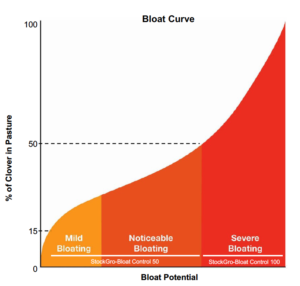Frothy Bloat
It is common for cattle producers in many parts of NSW and northern Victoria to experience bloat from autumn through to spring, especially if they graze pastures high in clover and lucerne (as well as grazing brassicas). What differs is how bloat is managed or controlled from farm to farm. Like grass tetany, bloat is very much a silent killer and can develop rapidly. In many cases, a herd moved onto risky pasture in the morning can experience significant losses by days end.
To stay on top of bloat, it is beneficial to identify what brings it on and how to control it.
Bloat Development
The proliferation of bloat this season will most likely stem from the drier and warmer winter temperatures experienced so far this year. Reportedly, this has already seen clover springing up in winter pastures and will likely see lush new growth come through as temperatures begin to rise in spring.
Pastures where clover accounts for more than 25% of ground cover are considered risky, with the bloat risk elevating to extreme beyond 50%. Lucerne is less of a concern until new, lush growth is generated, which can come on the back of a single rain event.

Clover cover can develop quickly, so it is important to continually monitor pastures and perform an accurate risk assessment.
Liquid feed bloat control products have proven to be very effective in preventing the development of and controlling symptoms of bloat. For medium-risk pastures with clover cover between 25% and 50% we recommend feeding StockGro-Bloat Control 50. However, where clover cover is greater than 50%, we recommend feeding StockGro-Bloat Control 100, which has double the concentration anti-foaming, bloat reduction agent TericPE62 and has proven to be effective high bloat risk pastures.
For best results, we recommend using StockGro-Bloat Control as a part of an integrated bloat management program including the following bloat management measures.
Bloat Management Measures (prevention is the best medicine)
- Dilution of the diet with straw or hay not only offsets intake of the ‘hot feed’ but also helps breakdown the foam and bubbles
- Strip or cell grazing management to limit over consumption of the offending pasture
- Water treatment (where possible) with ANP’s Teric Bloat Liquid 250
- Bloat blocks can help mild bloat, but anecdotal evidence suggests that they are relatively ineffective under severe challenges
- Twice daily drenching with a bloat oil such as ANP’s Teric Bloat Liquid 250 (possibly only practical for dairy farmers)
It is also recommended to keep a drum of ANP’s Teric Bloat Liquid 250 in your vehicle to orally drench animals that are down with bloat. Drench at the following dose rates:
- Cattle – 100mL drench
- Sheep – 40mL drench
Observe animals after application and re-apply if required. If animals don’t respond to treatment seek veterinary assistance.
StockGro-Bloat Control
StockGro-Bloat Control 100 and Bloat Control 50 provide different doses of Teric PE62 and essential minerals and trace elements in a palatable liquid supplement to aid in the control of bloat at differing levels of challenge. Teric PE62 is by far, the best anti-foaming agent on the market and rapidly reduces bloat symptoms by clearing the build-up of bubbles in the rumen.
If you would like more information regarding our products, please contact the team at ANP.